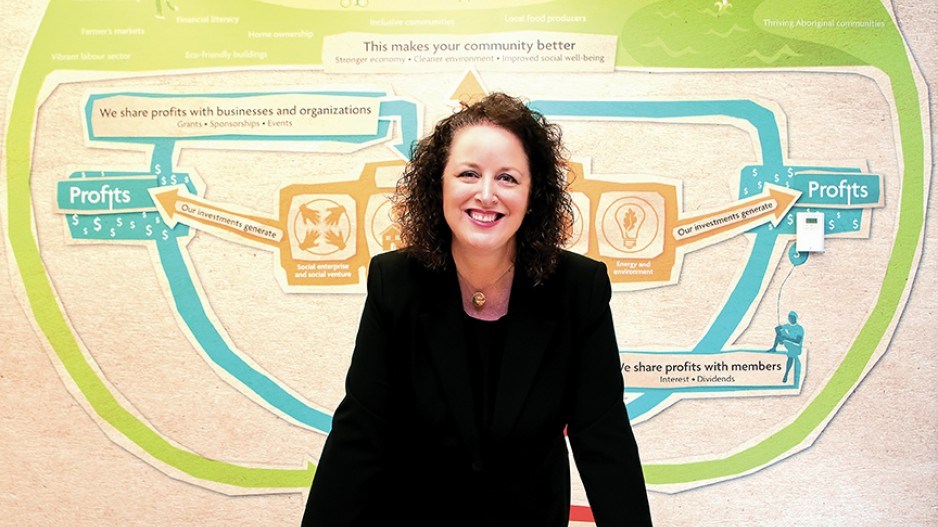Like many women, Kristin Bower struggles with depression and anxiety. Five years ago, she experienced a major depressive episode while she was employed at Vancity credit union. “I struggled to make it work,” she recalls, “but it was a classic case of presenteeism. I was at my desk but I wasn’t really able to function.”
At the time, Bower says, there wasn’t a lot of conversation about mental illness in her organization and managers weren’t always sure how to support an employee going through major depression. She continued to struggle; eventually, she couldn’t continue working and went on disability leave.
Her story isn’t unusual. According to the Mental Health Commission of Canada, in any given week 500,000 Canadians are unable to work due to mental health problems or illnesses. What is unique, however, is Bower’s perspective. As a human resources professional, she saw her mental health issues in the workplace from not only a personal point of view but an HR one. When she returned to work, she became determined to help Vancity better support other employees going through similar struggles.
“It’s been a learning journey for both me and the organization,” she says. Bower now leads the diversity and inclusion work at Vancity, a position that includes fostering a mentally healthy work environment. She has spoken at a Canadian Mental Health Association conference on mental health in the workplace, in collaboration with the Mental Health Commission of Canada, and for Partners for Mental Health, an organization that seeks to change attitudes towards people living with a mental illness. Additionally, she writes about mental health for Vancity’s blog and for her own blog (adventuresofasurvivor.blogspot.ca).
While mental illness has long been a taboo subject in the workplace, organizations such as Vancity are starting to tackle the issue more proactively. Not only does this make sense in terms of employee health and well-being, it also makes business sense. According to the Mental Health Commission of Canada, at any moment one in five Canadians is experiencing a mental health issue. About 30 per cent of short- and long-term disability claims in Canada are attributed to mental health problems and illnesses, and the total cost from mental health problems to the Canadian economy exceeds $50 billion annually. In 2011, mental health problems and illnesses among working adults in Canada cost employers more than $6 billion in lost productivity from absenteeism, presenteeism and turnover.
You might not see mental illness in your workplace, but it’s there. “Women with mental health issues don’t look like what you think they look like,” says Bev Gutray, CEO of the Canadian Mental Health Association’s British Columbia division. She says the media typically illustrate pieces on depression with a photo of a sobbing woman. But those experiencing mental health issues in the workplace may not appear visibly distraught. In fact, work may be the one place where they can appear in control.
“You can often show up and function in a very limited time,” explains Gutray. “It’s like being called to the stage…. But as soon as you’re off the stage what you’re dealing with is acute.”
Gutray explains that factors contributing to mental illness come from both the home and the workplace, and one merges into the other. “Women need to understand gender issues and gender context that affects their mental health,” she says. For example, a woman’s mental well-being at work may be affected by things like harassment, lower income, lower status or insufficient benefits or child care. At home, she may be juggling multiple roles and dealing with stress as a mother and/or caregiver. Women also deal with hormonal changes related to pregnancy and menopause, as well as societal issues such as body image.
Gutray also notes that women carry their experience of trauma into the workplace. While the majority of the public thinks of post-traumatic stress disorder in terms of police officers, firefighters and first responders, “women who live with violence at home, who are sexually abused, are really the dominant group of people who live with and survive post-traumatic stress disorder.” Women are also more susceptible to depression and anxiety than are men.
So how can employers help employees deal with mental health challenges in the workplace? Gutray says they can foster open conversation about mental health and acknowledge that these issues affect leaders, managers and supervisors just as they do entry-level employees. “Real change in the workplace for women’s mental health and well-being comes from leaders talking about their own mental health,” she says. “It opens the conversation for so many people who report to you to get the help that they need.” She urges leaders to “create a culture where your managers communicate the message that help is available early, not only for you but for your family.”
At Vancity, Bower also emphasizes the need to foster open conversation in the workplace about mental health. “I’ve had many managers say to me, ‘I think an employee is struggling with a mental health issue. What do I do?’ And I say to them, don’t wait until they’re in that mental health crisis. Normalize the topic so you’re creating an environment where employees know it’s OK to talk about this. And then maybe they won’t get to the crisis stage.”




